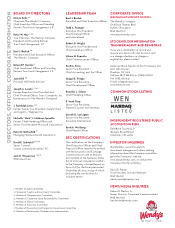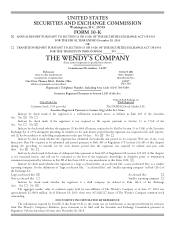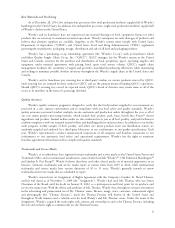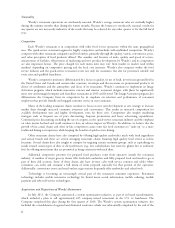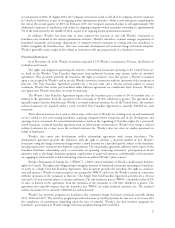Wendy's 2014 Annual Report Download - page 10
Download and view the complete annual report
Please find page 10 of the 2014 Wendy's annual report below. You can navigate through the pages in the report by either clicking on the pages listed below, or by using the keyword search tool below to find specific information within the annual report.Seasonality
Wendy’s restaurant operations are moderately seasonal. Wendy’s average restaurant sales are normally higher
during the summer months than during the winter months. Because the business is moderately seasonal, results for
any quarter are not necessarily indicative of the results that may be achieved for any other quarter or for the full fiscal
year.
Competition
Each Wendy’s restaurant is in competition with other food service operations within the same geographical
area. The quick-service restaurant segment is highly competitive and includes well-established competitors. Wendy’s
competes with other restaurant companies and food outlets, primarily through the quality, variety, convenience, price,
and value perception of food products offered. The number and location of units, quality and speed of service,
attractiveness of facilities, effectiveness of marketing and new product development by Wendy’s and its competitors
are also important factors. The price charged for each menu item may vary from market to market (and within
markets) depending on competitive pricing and the local cost structure. Wendy’s also competes within the food
service industry and the quick-service restaurant sector not only for customers, but also for personnel, suitable real
estate sites and qualified franchisees.
Wendy’s competitive position is differentiated by a focus on quality, its use of fresh, never frozen ground beef in
the United States and Canada and certain other countries, its unique and diverse menu, its promotional products, its
choice of condiments and the atmosphere and decor of its restaurants. Wendy’s continues to implement its Image
Activation program, which includes innovative exterior and interior restaurant designs, with plans for significantly
more new and reimaged company and franchisee restaurants in 2015 and beyond. The Image Activation program also
differentiates the Company from its competitors by its emphasis on selection and performance of restaurant
employees that provide friendly and engaged customer service in our restaurants.
Many of the leading restaurant chains continue to focus on new unit development as one strategy to increase
market share through increased consumer awareness and convenience. This results in increased competition for
available development sites and higher development costs for those sites. Competitors also employ marketing
strategies such as frequent use of price discounting, frequent promotions and heavy advertising expenditures.
Continued price discounting, including the use of coupons, in the quick-service restaurant industry and the emphasis
on value menus has had and could continue to have an adverse impact on Wendy’s. In addition, we believe that the
growth of fast casual chains and other in-line competitors causes some fast food customers to “trade up” to a more
traditional dining out experience while keeping the benefits of quick-service dining.
Other restaurant chains have also competed by offering high quality sandwiches made with fresh ingredients
and artisan breads and there are several emerging restaurant chains featuring high quality food served at in-line
locations. Several chains have also sought to compete by targeting certain consumer groups, such as capitalizing on
trends toward certain types of diets or diet preferences (e.g., low carbohydrate, low trans fat, gluten free or antibiotic
free) by offering menu items that are promoted as being consistent with such diets.
Additional competitive pressures for prepared food purchases come from operators outside the restaurant
industry. A number of major grocery chains offer fresh deli sandwiches and fully prepared food and meals to go as
part of their deli sections. Some of these chains also have in-store cafes with service counters and tables where
consumers can order and consume a full menu of items prepared especially for that portion of the operation.
Additionally, convenience stores and retail outlets at gas stations frequently offer sandwiches and other foods.
Technology is becoming an increasingly critical part of the restaurant consumer experience. Restaurant
technology includes mobile interactive technology for brand menu search information, mobile ordering, mobile
payment and other self-service technologies.
Acquisitions and Dispositions of Wendy’s Restaurants
In July 2013, the Company announced a system optimization initiative, as part of its brand transformation,
which included a plan to sell approximately 425 company-owned restaurants in the U.S. to franchisees. The
Company completed this plan during the first quarter of 2014. The Wendy’s system optimization initiative also
included the consolidation of regional and divisional territories, which was substantially completed by the end of the
6


